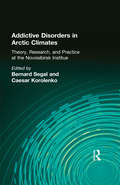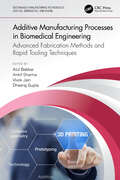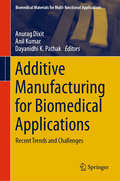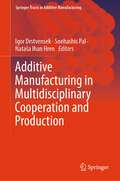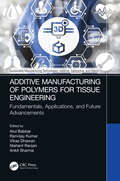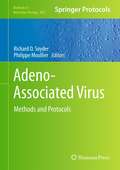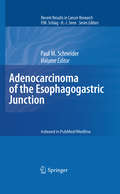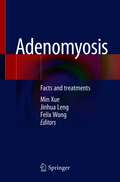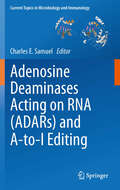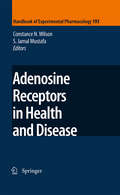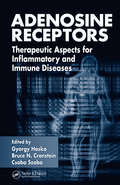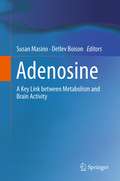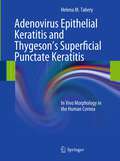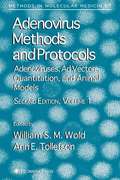- Table View
- List View
Addictive Disorders in Arctic Climates: Theory, Research, and Practice at the Novosibirsk Institute
by Bernard SegalDiscover fresh perspectives on alcoholism treatment and research with this enlightening new book describing the work of researchers at the Novosibirsk Medical Institute, USSR. By using specific examples of their studies in Siberia, the reserachers offer an innovative approach to the treatment of addictive disorders in general. Instead of focusing on the drinking behavior itself, the treatment focuses on the relation of the problem to the interaction of economic, social, and psychological factors. To address the question of whether alcoholics should all be treated in the same way, or if alcholism treatment should be more individualized in approach, chapters are devoted to the differences between alcoholism in women, adolescents, and alchoholics who are afflicted with “rapid development of alcholism syndrome.” The research examples in Addictive Disorders in Arctic Climates benefits professionals involved in the treatment of alcholism by introducing new perspectives and broadening contemporary research.
Additive Manufacturing Processes in Biomedical Engineering: Advanced Fabrication Methods and Rapid Tooling Techniques (Sustainable Manufacturing Technologies)
by Ankit Sharma Vivek Jain Atul Babbar Dheeraj GuptaThis book covers innovative breakthroughs in additive manufacturing processes used for biomedical engineering. More and more, 3D printing is selected over traditional manufacturing processes, especially for complex designs, because of the many advantages such as fewer restrictions, better production cost savings, higher quality control, and accuracy. Current challenges and opportunities regarding material, design, cost savings, and efficiency are covered along with an outline of the most recent fabrication methods used for converting biomaterials into integrated structures that can fit best in anatomy while still obtaining the necessary architecture, mechanical reliability, biocompatibility, and anti-bacterial characteristics needed. Additional chapters will also focus on selected areas of applications such as bionics, affordable prostheses, implants, medical devices, rapid tooling, and drug delivery. Additive Manufacturing Processes in Biomedical Engineering: Advanced Fabrication Methods and Rapid Tooling Techniques acts as a first-hand reference for commercial manufacturing organizations which are mimicking tissue organs by using additive manufacturing techniques. By capturing the current trends of today’s manufacturing practices this book becomes a one-stop resource for manufacturing professionals, engineers in related disciplines, and academic researchers.
Additive Manufacturing for Biomedical Applications: Recent Trends and Challenges (Biomedical Materials for Multi-functional Applications)
by Anil Kumar Anurag Dixit Dayanidhi K. PathakNew fabrication techniques and biomaterials have advanced significantly as attention toward healthcare innovations in recent decades has increased. This book provides a comprehensive overview of the application of additive manufacturing for biomedical devices. The book focuses on the use of biomaterial for hard and soft tissue engineering. These materials can imitate the mechanical, structural, and biological characteristics of the parent tissue, repairing or replacing its functioning. It provides details on the use of various biomaterials for different biomedical applications. It highlights the present trends and potential of various techniques and materials for various applications. The chapters in this book written by eminent experts highlight recent developments in additive manufacturing for biological mimicking and surgical planning. It discusses latest advances in various 3D printing technologies in the fabrication of biomedical devices for orthopaedic and cardiovascular applications, along with rising trends in designing and creating tissue replacement substitute simulants. This book can serve as a fundamental textbook for research in additive manufacturing, fabrication of implants or scaffolds and medical device development, biomaterials, tissue engineering, and biomedical engineering. This book can be a valuable resource for mechanical and biomedical engineers, academicians, healthcare researchers, and professionals interested in tissue engineering.
Additive Manufacturing for Biomedical Implants and Prosthetics (Advanced Materials Processing and Manufacturing)
by Pravin KumarThis book explains usage of additive manufacturing (AM) for the printing of biomedical implants and prosthetics. It elaborates on the basics of printing biomedical implants and prosthetics, including necessity, printing processes, materials, and standards followed by discussion of involved technologies, design and optimization, and post-processing. It further highlights patient response and risks of biomedical implants, including future scope. Sustainability and environmental concerns while AM of implants and process optimization are also covered.Book highlights Provides wide coverage of the contents related to additive manufacturing (AM) of bio-implants and prosthetics Details fabrication details, properties, and features of fabricated implants, their testing, and characterization Discusses environmental issues and optimization Covers economic implications of AM in biomedical industry Includes dedicated chapters on Industry 4.0 interventions and sustainability This book is aimed at graduate students and researchers in bioengineering, materials science, implant design, and fabrication.
Additive Manufacturing in Multidisciplinary Cooperation and Production (Springer Tracts in Additive Manufacturing)
by Igor Drstvensek Snehashis Pal Nataša Ihan HrenThis book publishes the latest findings and ideas in the field of additive manufacturing presented by authors from prominent institutions around the world at the iCAT 2023 conference. The authors address various technological and medical aspects, ranging from materials science to the specific behaviour of the technology under different working conditions. The book is divided into four sections, three of which are dedicated to the purely technological aspects of additive manufacturing, covering metal processes, polymer processes and simulation. The fourth part of the book is dedicated to the medical applications of additive manufacturing, covering areas ranging from orthopaedic surgeries to materials used in medical AM.Overall, the book provides insight into the current state of the science and applications of additive manufacturing.
Additive Manufacturing in Pharmaceuticals
by Subham BanerjeeThis book presents the different 3D/4D printing technological applications of Additive Manufacturing (AM) in Pharmaceutical Sciences. The initial chapter provides the historical perspective and current scenario of AM in pharmaceuticals. The book further discusses about different 3D printing platform technologies such as FDM, SLA, SLS, SSE, Ink-jet & binder jet principles & applications in developing advanced drug delivery systems. It also covers the methodology, materials for AM and important parameters associated with these platform technologies. The book highlights the progress and practical applications of 4D-printing technology in healthcare & pharmaceuticals fraternity as well including the essence of bioprinting in pharmaceuticals. Finally, the book reviews the regulatory guidelines, perspectives, and integration of Artificial Intelligence (AI)/Machine learning (ML) in pharmaceutical AM. This book is indeed a valuable resource for students, researchers/scholars, young start-ups/entrepreneurs, and pharmaceutical professionals by providing thorough detailing about AM in Pharmaceuticals.
Additive Manufacturing of Polymers for Tissue Engineering: Fundamentals, Applications, and Future Advancements (Sustainable Manufacturing Technologies)
by Ankit Sharma Ranvijay Kumar Atul Babbar Vikas Dhawan Nishant RanjanApplication of additive manufacturing and tissue engineering in the fields of science and technology enables the manufacturing of biocompatible, customized, reliable, and cost-effective parts, restoring the functionality of a failed human body part. This book offers a platform for recent breakthroughs in additive manufacturing related to biomedical applications. This book highlights some of the top innovations and advances in additive manufacturing and processing technologies that are the future of the manufacturing industry while also presenting current challenges and opportunities regarding the choice of material. This book includes areas of applications such as surgical guides, tissue regeneration, artificial scaffolds, implants, and drug delivery and release. Throughout the book, an emphasis is placed on rapid tooling for engineering applications. Additive Manufacturing of Polymers for Tissue Engineering: Fundamentals, Applications, and Future Advancements acts as a first-hand source of information for academic scholars and commercial manufacturers as they make strategic manufacturing and development plans.
Addressing The Nation's Changing Needs For Biomedical And Behavioral Scientists
by National Research CouncilAs biomedical and behavioral research progresses into new areas, the number of scientists active in various fields rises and falls, and the health needs of the U.S. population evolve, it is important to ensure that the preparation of future investigators reflects these changes. This book addresses these topics by considering questions such as the following: What is the current supply of biomedical and behavioral scientists? How is future demand for scientists likely to be affected by factors such as advances in research, trends in the employment of scientists, future research funding, and changes in health care delivery? What are the best ways to prepare prospective investigators to meet future needs in scientific research?In the course of addressing these questions, this volume examines the number of investigators trained every year, patterns of hiring by universities and industry, and the age of the scientific workforce in different fields, and makes recommendations for the number of scientists that should be trained in the years ahead.This book also considers the diversity of the research workforce and the importance of providing prospective scientists with the skills to successfully collaborate with investigators in related fields, and offers suggestions for how government and universities should structure their research training programs differently in the future.
Addressing Unhealthy Alcohol Use in Primary Care
by Richard SaitzWhile there is a wealth of published information on addiction medicine, the psychological aspects of alcohol abuse, and behavioral medicine with regard to addiction, virtually none of these resources were written with the primary care provider in mind. Addressing Unhealthy Alcohol Use in Primary Care is a resource for primary care clinicians who are confronted by patients with these problems daily, and who wish to successfully address these issues in their practice. It would focus on the literature and science relevant to primary care practice and cover the range of interventions appropriate for this setting. Topics include assessment, brief counseling interventions, pharmacotherapy, referrals to both specialty care and Alcoholics Anonymous (and other self-help programs), psychiatric co-morbidity and other drug use, and other information specific to the needs of the primary care provider.
Addressing Violence, Abuse and Oppression: Debates and Challenges
by Barbara Fawcett Fran WaughEveryone working in health and social care is at one point or another confronted by violent behaviour and its consequences. Addressing Violence, Abuse and Oppression provides a broad overview of violence in relation to a range of groups and areas that involve human service professionals. Adopting an international perspective, this book looks at the ways in which violence, abuse and oppression can be clearly associated with power imbalances which are often gendered and which are covertly or overtly manifested at a range of levels including the interpersonal as well as the organizational and the political. It explores debates and challenges with regard to theoretical orientations, policy frameworks and how power imbalances intersect with a range of influencing factors including gender, poverty, indigenous/ethnic issues, class and sexuality. Examining the implications for human service professionals, each chapter of Addressing Violence, Abuse and Oppression provides an historical overview, explores theoretical perspectives, examines specific policy and practice context, appraises the contribution from research and assesses the impact for individuals and groups.
Addressing the Threat of Drug-Resistant Tuberculosis: A Realistic Assessment of the Challenge - Workshop Summary
by Institute of Medicine of the National AcademiesTuberculosis is one of the leading causes of death in the world today, with 4,500 people dying from the disease every day. Many cases of TB can be cured by available antibiotics, but some TB is resistant to multiple drugs--a major and growing threat worldwide. The Institute of Medicine's Forum on Drug Discovery, Development, and Translation hosted a workshop on November 5, 2008, to address the mounting concern of drug-resistant TB. The session brought together a wide range of international experts to discuss what is known and not known about this growing threat, and to explore possible solutions.
Adeno-Associated Virus: Methods and Protocols (Methods in Molecular Biology #807)
by Richard O. Snyder Philippe MoullierToday, progress in rAAV-mediated gene transfer is so robust that long-term, efficient, and regulatable transgene expression is reproducibly achieved in large animal models. The complexity of gene transfer agents in the context of their clinical use requires investigators from a wide variety of backgrounds to have an understanding -- or at least an appreciation of -- the regulatory environment and constraints that affect vector design, manufacturing, pre-clinical testing, and clinical use, with an emphasis on patient protection. In Adeno-Associated Virus: Methods and Protocols, experts from the United States and Europe have contributed current knowledge of this multi-dimensional field relating to the biology of AAV, rAAV vector design, vector manufacturing and product testing, performance of rAAV vectors in major organs, rAAV-related immunological issues, design of animal and clinical studies, and clinical experience. Written in the successful Methods in Molecular BiologyTM series format, chapters include introductions to their respective topics, lists of the necessary materials and reagents, step-by-step, readily reproducible protocols, and notes on troubleshooting and avoiding known pitfalls. Authoritative and accessible, Adeno-Associated Virus: Methods and Protocols provides a complete and comprehensive understanding of this multi-disciplinary and rapidly progressing field.
Adenocarcinoma of the Esophagogastric Junction: Adenocarcinoma Of The Esophagogastric Junction (Recent Results in Cancer Research #182)
by Paul M. SchneiderAmong malignant tumors, adenocarcinomas of the esophagogastric junction show the highest increase in incidence over the past three decades in Western industrialized countries. This special volume, with contributions from experts in the field, covers all aspects of the disease. Etiology, pathogenesis, classification, and clinical staging are discussed, and there is special emphasis on state of the art treatment techniques. The latter range from endoscopic mucosal resections or limited surgical resections for early cancers to multimodality treatment options for locally advanced tumors. Emerging quality issues in surgical management are addressed. Detailed attention is also paid to other important recent developments, including molecular response prediction, early metabolic response evaluation by PET and PET-CT, the diagnosis of micrometastases, and the use of sentinel node technology. This volume will be of interest to all clinicians concerned with the diagnosis and management of this malignancy.
Adenocarcinoma of the Esophagogastric Junction: From Barrett's Esophagus to Cancer
by Simone Giacopuzzi Andrea Zanoni Giovanni ManzoniThis book offers up-to-date and comprehensive coverage of the diagnosis and therapy of adenocarcinoma of the esophagogastric junction (EGJ). As is appropriate in the era of multidisciplinary and multimodal treatment, the contributions of all the various specialists involved cooperatively in the treatment of EGJ cancer are thoroughly described. Detailed attention is also paid to the significance of preneoplastic lesions, such as Barrett esophagus. The final part of the book represents a surgical atlas documenting the techniques used in the EGJ region, with superb color images and stepwise description of procedures. Against the background of the rapidly increasing incidence in EGJ cancer, especially evident in Western countries, there is a need for greater uniformity in management strategies, which currently vary significantly across the world. This book provides appropriate guidance that will assist all practitioners involved in the diagnosis and treatment of EGJ cancers, including surgeons, oncologists, and radiotherapists.
Adenomyosis: Facts and treatments
by Felix Wong Min Xue Jinhua LengThis book aims to provide updated facts and treatments for practicing gynecologists and postgraduate doctors to enhance their understanding of pathogenesis, pathology, symptoms and diagnostic imaging technology of adenomyosis, such as to select appropriate treatments, to improve the symptoms, fertility and the quality of life of women with adenomyosis. This book also particularly introduces the new treatment for adenomyosis using the non-invasive High Intensity Focused Ultrasound ablation treatment. Hopefully, it will provide a better understanding of its operation, effectiveness, and pregnancy outcome, to formulate a more successful treatment strategy for this disease.
Adenosine Deaminases Acting on RNA (Current Topics in Microbiology and Immunology #353)
by Charles E. Samuel"The objective of this CTMI volume is to provide readers with a foundation for understanding what ADARs are and how they act to affect gene expression and function. It is becoming increasingly apparent that ADARs may possess roles not only as enzymes that deaminate adenosine to produce inosine in RNA substrates with double-stranded character, but also as proteins independent of their catalytic property. Because A-to-I editing may affect base-pairing and RNA structure, processes including translation, splicing, RNA replication, and miR and siRNA silencing may be affected. Future studies of ADARs no doubt will provide us with additional surprises and new insights into the modulation of biological processes by the ADAR family of proteins."
Adenosine Receptors in Health and Disease (Handbook of Experimental Pharmacology #193)
by Constance N. Wilson S. Jamal MustafaSince their discovery approximately 25 years ago, adenosine receptors have now emerged as important novel molecular targets in disease and drug discovery. These proteins play important roles in the entire spectrum of disease from inflammation to immune suppression. Because of their expression on a number of different cell types and in a number of different organ systems they play important roles in specific diseases, including asthma, rheumatoid arthritis, Parkinson's disease, multiple sclerosis, Alzheimer's disease, heart disease, stroke, cancer, sepsis, and obesity. As a result of intense investigations into understanding the molecular structures and pharmacology of these proteins, new molecules have been synthesized that have high specificity for these proteins and are now entering clinical trials. These molecules will define the next new classes of drugs for a number of diseases with unmet medical needs.
Adenosine Receptors: Therapeutic Aspects for Inflammatory and Immune Diseases
by Csaba Szabó Bruce N. Cronstein György HaskóAfter a century of research, several lines of evidence now indicate that the ability of adenosine to directly control inflammatory cells has a major impact on the functions of the inflammatory and immune systems. Consequently, many promising therapeutic approaches are beginning to emerge that focus on the modulation of adenosine, including the deve
Adenosine and Adenine Nucleotides As Regulators of Cellular Function
by John W. PhillisThis book provides valuable information for investigators interested in the signaling and regulatory functions of adenosine and the adenine nucleotides. Topics covered in this comprehensive volume include the historical development of research on adenosine and adenosine triphosphate; various aspects of the formation, metabolism, release, transport, and receptors for endogenous adenosine and the adenosine triphosphate; functions of purines at the cellular level; the role of adenosine in the regulation of flow in different vascular beds; and angiogenesis. The book also addresses the purinergic regulation of the cardiac, renal, gastro-intestinal, and central nervous system, as well as potential therapeutic avenues for purine use. The book will be valuable to physiologists, pharmacologists, and other basic and clinical scientists interested in updating their knowledge of the expanding biological roles of these substances.
Adenosine: A Key Link between Metabolism and Brain Activity
by Susan Masino Detlev BoisonHomeostasis of key metabolites and metabolic health affects all bodily systems. Not surprisingly, altered metabolic function is associated with a wide spectrum of dysfunctions in the central nervous system - including developmental disorders, acute nervous system injury, and neurodegenerative disorders. Accordingly, metabolism-based therapies offer significant promise as new category of treatment options designed to limit, delay or reverse the disease process by reconstructing homeostatic functions. Increasingly it is appreciated that restoring metabolic health could promote normal nervous system activity, and improve behavior and cognition. Adenosine: A Key Link Between Metabolism and Central Nervous System Activity focusses on diverse aspects of adenosine, an evolutionarily conserved homeostatic bioenergetic regulator in the central nervous system. Because of its interrelationship with ATP (adenosine triphosphate), adenosine is integral to cell metabolism. At the same time, adenosine influences neuronal activity directly via receptors, and is involved in biochemical processes related to gene expression. Thus, adenosine is uniquely placed as a reciprocal and rapid link between changes in metabolism and changes in neuronal activity, and, on a longer time scale, to changes in gene expression and long term changes in cell function. Leaders in the field feature basic research on adenosine at the cellular level in the central nervous system, and relate these findings to its recognized potential in diverse acute and chronic disorders. This comprehensive overview of adenosine also highlights emerging adenosine-based treatments and associated opportunities for central nervous system disorders.
Adenovirus Epithelial Keratitis and Thygeson's Superficial Punctate Keratitis: In Vivo Morphology in the Human Cornea
by Helena M. TaberyDespite differences in frequency, causation, and infectivity, adenovirus epithelial keratitis and Thygeson's superficial punctate keratitis (TSPK) are often confused in clinical practice owing to the similarity between adenovirus epithelial infiltrates and 'coarse' epithelial TSPK lesions. This book presents the morphological features, dynamics, and sequelae of adenovirus and Thygeson's keratitides captured at high magnification in the living human cornea. It thereby fills the existing void between conventional photographs and slit-lamp observations. Case reports demonstrate the importance of patient history in differential diagnosis, illustrate the need for familiarity with early manifestations of adenovirus infections, and assist in the diagnosis of rare variants of TSPK. Furthermore, the detailed observations on the natural course of the diseases ensure that the book will serve not only as a diagnostic tool but also as a reference when evaluating the effects of potential new treatments.
Adenovirus Methods and Protocols, Second Edition, Volume 1: Volume 1: Adenoviruses, Ad Vectors, Quantitation, and Animal Models (Methods in Molecular Medicine #130)
by William S. Wold Ann E. TollefsonAdenovirus Methods and Protocols, Second Edition, now in two volumes, is an essential resource for adenovirus (Ad) researchers beginning in the field, and an inspirational starting point for researchers looking to branch into new areas of Ad study. In addition to updating and expanding the first edition, the authors have added new chapters that address innovative areas of emphasis in Ad research, including Ad vector construction and use, real-time PCR, use of new animal models, and methods for quantification of Ad virus or virus expression/interactions. Each of the protocols presented in these volumes is written by trendsetting researchers.
Adenovirus Methods and Protocols, Second Edition, Volume 2: Volume 2: Ad Proteins and RNA, Lifecycle and Host Interactions, and Phyologenetics (Methods in Molecular Medicine #131)
by William S. Wold Ann E. TollefsonAdenovirus Methods and Protocols, Second Edition, now in two volumes, is an essential resource for adenovirus (Ad) researchers beginning in the field, and an inspirational starting point for researchers looking to branch into new areas of Ad study. In addition to updating and expanding the first edition, the authors have added new chapters that address innovative areas of emphasis in Ad research, including Ad vector construction and use, real-time PCR, use of new animal models, and methods for quantification of Ad virus or virus expression/interactions. Each of the protocols presented in these volumes is written by trendsetting researchers.
Adenovirus Methods and Protocols: Volume 2: Ad Proteins And Rna, Lifecycle And Host Interactions, And Phyologenetics (Methods in Molecular Medicine #21)
by William S. WoldIn Adenovirus Methods and Protocols, William S.M. Wold has organized a collection of readily reproducible methods for conducting research with adenoviruses, the premier and most widely used model in cell and molecular biology. The methods range from how to grow and titer adenoviruses and how to construct specific alterations in the adenovirus genome, to how to measure apoptosis induced by cells of the immune system, cytokines, and intrinsic apoptosis effectors. In addition, there are methods to study transcription and splicing with in vitro systems and for the adenovirus-mediated transformation of cells to a malignant state. Each method is written by a prominent investigator well-versed in the technique and includes a brief background discussion, as well as tried and true step-by-step instructions.<P><P> Adenovirus Methods and Protocols will be useful to both entry-level and senior scientists seeking to enter the adenovirus field, to researchers from other areas wishing to construct adenovirus vectors for their own research, and to adenovirologists wanting to enter new sectors of research. Its cutting-edge techniques are certain to make it today's reference of choice, one from which even expert researchers will learn many productive and time-saving techniques.
Adequacy Of Evidence For Physical Activity Guidelines Development: Workshop Summary
by Institute of Medicine of the National AcademiesIs there a sufficient evidence base for the U.S. Department of Health and Human Services (HHS) to develop a comprehensive set of physical activity guidelines for Americans? To address this question, the Institute of Medicine (IOM) held a workshop titled "Adequacy of Evidence for Physical Activity Guidelines Development" in Washington, DC on October 23-24, 2006, sponsored by HHS. The workshop summary includes the presentations and discussions of more than 30 experts who were asked to consider the available evidence related to physical activity and the general population, as well as special population subgroups including children and adolescents, pregnant and postpartum women, older adults, and persons with disabilities. The summary provides an overview of the specific issues of relevance in assessing the quality and breadth of the available evidence.
